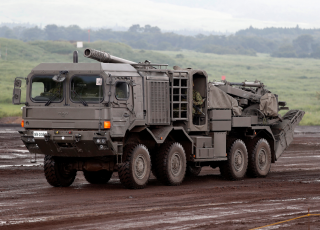Japanese Hypersonic Missiles? Oh God Yes.
Japan’s hypersonic missile is a direct response to China’s years-long campaign of maritime land-grabs and fortress-construction in the South and East China Seas.
Here's What You Need to Remember: The Japanese military’s existing land-based weapons lack the range to strike, from Japanese soil, the outermost Chinese outposts.
The Japanese military is considering developing a hypersonic anti-ship missile with a special warhead for penetrating the decks of Chinese aircraft carriers.
Japan's defense ministry is developing what it calls a “hypervelocity gliding projectile," or HVGP, for deployment on island bases starting in 2026.
The Japanese weapon’s designation is something of a misnomer. In U.S. parlance, a guided missile traveling faster than five times the speed of sound is a “hypersonic” weapon. The Americans reserve the “hypervelocity” designation for fast, unguided cannon shells.
In any event, Tokyo wants the new HVGP to help it defeat Chinese forces. The 2026 model is for “targeting a potential enemy invading Japan's remote islands,” The Mainichi newspaper reported. “In the second stage, an upgraded type will be developed for possible installation in fiscal 2028 or later, featuring claw-shaped payloads, enhanced speeds and firing ranges and more complex trajectories.”
Another enhancement after 2026 could add a “payload that is capable of penetrating the deck of aircraft carriers,” Mainichi explained.
The HVGP is a boost-glide system. It launches atop a rocket then separates from the booster and, guided by GPS, glides at hypersonic speed toward its target while making small course corrections.
It’s unclear what special “payload” the Japanese are considering specifically for targeting Chinese aircraft carriers. The kinetic energy of a hypersonic missile alone should be sufficient to disable or destroy most targets.
After decades of development, hypersonic weapons finally are beginning to enter front-line service. The Russian defense ministry in late 2019 claimed it had deployed the Avangard surface-to-surface hypersonic missile, possibly making Russia one of the first countries to field an operational hypersonic weapon.
Chinese media claimed China is testing two hypersonic surface-to-surface missiles. The DF-17 made its first public appearance as part of the October 2019 celebrations commemorating the 70th anniversary of the founding of the People’s Republic of China. The second missile, the Xingkong-2, reportedly differs in detail compared to the DF-17.
The U.S. Air Force successfully conducted a flight test of its own hypersonic Air-Launched Rapid-Response Weapon back in June 2019. The ALRRW could enter service as early as 2023. The B-1 and B-52 bombers both are possible launch platforms for the new weapon.
The U.S. Navy and U.S. Army meanwhile are working together on a booster for a Mach-5-plus missile plus a common glide body for a hypersonic weapon’s second stage. The Navy has identified the new Block V version of its Virginia-class attack submarine as the initial launch platform for the fast missile.
Japan’s hypersonic missile is a direct response to China’s years-long campaign of maritime land-grabs and fortress-construction in the South and East China Seas. “Chinese government vessels have been frequently spotted navigating in contiguous zones near the Senkaku Islands and intruding into Japanese territorial waters,” Mainichi noted.
The Japanese military’s existing land-based weapons lack the range to strike, from Japanese soil, the outermost Chinese outposts. “While the main island of Okinawa and the Senkakus are about 420 kilometers [261 miles] apart, the [Japanese army’s] current missile range is set at just over a hundred kilometers [62 miles],” Mainichi reported.
“The introduction of longer-range gliding missiles to protect the Nansei Islands would make it possible for Japan to respond to China's activities without deploying the Maritime Self-Defense Force's vessels and aircraft.”
The Defense Ministry allocated a total of 18.5 billion yen [$170 million] in the fiscal 2018 and 2019 budgets for research on HVGPs for the defense of remote islands, and plans to add another 25 billion yen [$230 million] in the fiscal 2020 budget,” the paper continued.
The new missile is years away from front-line service, but already is causing controversy, Mainichi explained. “Some legislators in the Diet have pointed out that acquisition of the new capabilities could ‘make it possible for the [Self-Defense Forces, i.e. the Japanese armed forces] to directly attack other countries' territories’ and ‘deviate from Japan's exclusively defense-oriented policy.’"
David Axe serves as Defense Editor of the National Interest. He is the author of the graphic novels War Fix, War Is Boring and Machete Squad. This article first appeared in February 2020.
Image: Reuters.

